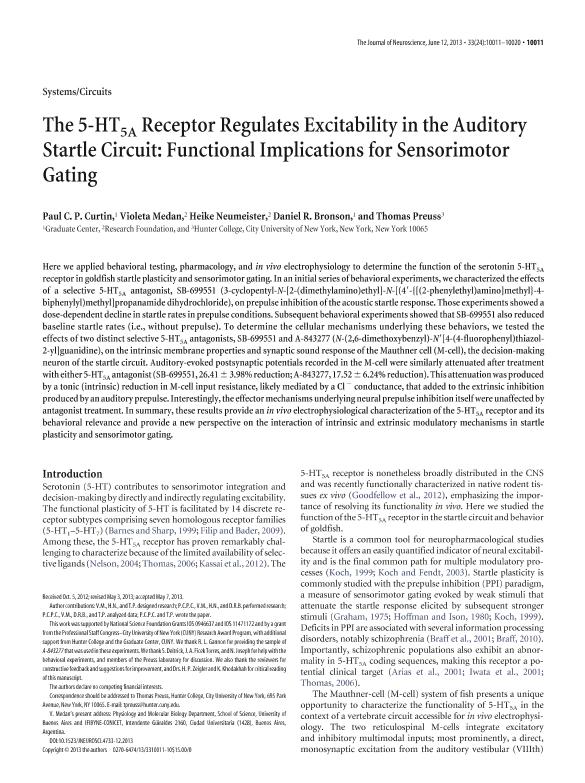Mostrar el registro sencillo del ítem
dc.contributor.author
Curtin, Paul C. P.
dc.contributor.author
Medan, Violeta

dc.contributor.author
Neumeister, Heike
dc.contributor.author
Bronson, Daniel R.
dc.contributor.author
Preuss, Thomas
dc.date.available
2017-07-17T20:37:18Z
dc.date.issued
2013-06
dc.identifier.citation
Curtin, Paul C. P.; Medan, Violeta; Neumeister, Heike; Bronson, Daniel R.; Preuss, Thomas; The 5-HT5A receptor regulates excitability in the auditory startle circuit: functional implications for sensorimotor gating; Society for Neuroscience; Journal of Neuroscience; 33; 24; 6-2013; 10011-10020
dc.identifier.issn
0270-6474
dc.identifier.uri
http://hdl.handle.net/11336/20745
dc.description.abstract
Here we applied behavioral testing, pharmacology, and in vivo electrophysiology to determine the function of the serotonin 5-HT5A receptor in goldfish startle plasticity and sensorimotor gating. In an initial series of behavioral experiments, we characterized the effects of a selective 5-HT5A antagonist, SB-699551 (3-cyclopentyl-N-[2-(dimethylamino)ethyl]-N-[(4 -{[(2-phenylethyl)amino]methyl}-4- biphenylyl)methyl]propanamide dihydrochloride), on prepulse inhibition of the acoustic startle response. Those experiments showed a dose-dependent decline in startle rates in prepulse conditions. Subsequent behavioral experiments showed that SB-699551 also reduced baseline startle rates (i.e., without prepulse). To determine the cellular mechanisms underlying these behaviors, we tested the effects of two distinct selective 5-HT5A antagonists, SB-699551 and A-843277 (N-(2,6-dimethoxybenzyl)-N [4-(4-fluorophenyl)thiazol- 2-yl]guanidine), on the intrinsic membrane properties and synaptic sound response of the Mauthner cell (M-cell), the decision-making neuron of the startle circuit. Auditory-evoked postsynaptic potentials recorded in the M-cell were similarly attenuated after treatment with either 5-HT5A antagonist (SB-699551, 26.413.98% reduction; A-843277, 17.526.24% reduction). This attenuation was produced by a tonic (intrinsic) reduction in M-cell input resistance, likely mediated by a Cl conductance, that added to the extrinsic inhibition produced by an auditory prepulse. Interestingly,the effector mechanisms underlying neural prepulse inhibition itself were unaffected by antagonist treatment. In summary, these results provide an in vivo electrophysiological characterization of the 5-HT5A receptor and its behavioral relevance and provide a new perspective on the interaction of intrinsic and extrinsic modulatory mechanisms in startle plasticity and sensorimotor gating.
dc.format
application/pdf
dc.language.iso
eng
dc.publisher
Society for Neuroscience

dc.rights
info:eu-repo/semantics/openAccess
dc.rights.uri
https://creativecommons.org/licenses/by-nc-sa/2.5/ar/
dc.subject
Mauthner
dc.subject
Startle
dc.subject
Serotonin Receptor 5a
dc.subject
Prepulse Inhibition
dc.subject.classification
Biofísica

dc.subject.classification
Ciencias Biológicas

dc.subject.classification
CIENCIAS NATURALES Y EXACTAS

dc.title
The 5-HT5A receptor regulates excitability in the auditory startle circuit: functional implications for sensorimotor gating
dc.type
info:eu-repo/semantics/article
dc.type
info:ar-repo/semantics/artículo
dc.type
info:eu-repo/semantics/publishedVersion
dc.date.updated
2017-07-11T13:24:29Z
dc.journal.volume
33
dc.journal.number
24
dc.journal.pagination
10011-10020
dc.journal.pais
Estados Unidos

dc.journal.ciudad
Washington DC
dc.description.fil
Fil: Curtin, Paul C. P.. City University Of New York; Estados Unidos
dc.description.fil
Fil: Medan, Violeta. City University Of New York; Estados Unidos. Consejo Nacional de Investigaciones Científicas y Técnicas; Argentina
dc.description.fil
Fil: Neumeister, Heike. City University Of New York; Estados Unidos
dc.description.fil
Fil: Bronson, Daniel R.. City University Of New York; Estados Unidos
dc.description.fil
Fil: Preuss, Thomas. City University Of New York; Estados Unidos
dc.journal.title
Journal of Neuroscience

dc.relation.alternativeid
info:eu-repo/semantics/altIdentifier/doi/http://dx.doi.org/10.1523/JNEUROSCI.4733-12.2013
dc.relation.alternativeid
info:eu-repo/semantics/altIdentifier/url/http://www.jneurosci.org/content/33/24/10011
Archivos asociados
